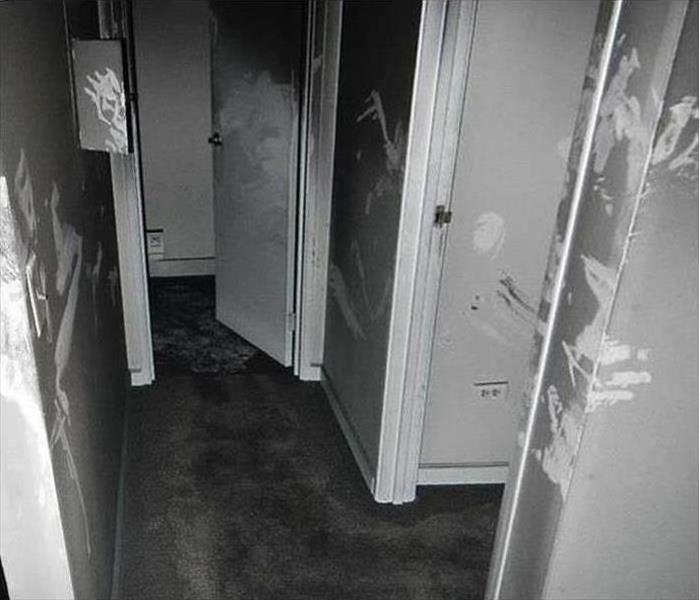Not All Fire Damages are Structural: What About Smoke Odor Damage?
10/5/2022 (Permalink)
If you've ever had an odor problem in your home, then you know that it can make the place feel less than welcoming. A new house or apartment will always have some sort of odor, but it should fade after a while. When they don't, then you may have a bigger problem on your hands: smoke odor damage. Smoke damage and smoke odor are two different things that can happen after a fire breaks out in your home. The first is obvious—the fire itself caused damage to the structural integrity of your house or apartment building—while the latter is more subtle and may not be as noticeable at first glance.
How to Clean and Restore Smoke Odor Damage
There are many ways smoke odor can be cleaned and restored. It depends on the severity of the damage and what type of restoration is needed. If your home has sustained heavy structural damage from a fire, it may not be possible to completely clean or restore your home without first repairing those damages.
If you have minimal structural damage from a fire, there are still methods available for cleaning up after smoke odor in your home so that it’s livable again (and smelling fresh). The process is different depending on what kind of restoration is needed and should always be performed by professionals who know how to handle these types of situations safely.
Different Ways to Handle Smoke Odor
There are several ways to handle smoke odor after fire damage. The first is by using air filtration devices that remove harmful volatile organic compounds (VOCs). VOCs are chemicals emitted by most materials and products, including paints, finishes, and adhesives; cleaning products; gasoline fumes; wood-burning stoves; floor coverings; furniture fabrics; upholstery foams or cushions; and dry cleaning chemicals.
Another way is through the use of ozone machines which produce ozone gas that oxidizes odors at their source. This method is effective in areas where it’s very difficult to remove smoke odor from carpets or drapes because they can be difficult to clean with water alone. However, this method only works if the materials are non-porous (made without holes).
Thermal foggers work by releasing tiny droplets of perfumes into the air when activated. This helps mask odors for a short period of time, but it doesn’t really eliminate them permanently as much as masking them until new smells take over again. These have to be used every couple of weeks until eventually all smells have been masked out completely. This may sound like a good thing but there really isn't anything good about thermal fogging except maybe as an alternative solution for those who don't want their whole house smelling poorly.
Smoke Damage and Smoke Odor Can Linger
Smoke odors are usually caused by the burning of materials, such as when you cook food on a stove or make toast on a toaster. Smoke damage can also be caused by natural disasters, like wildfires or earthquakes resulting in fires.
Smoke damage is often due to a house fire, but not always; some items that are not usually considered flammable can actually burn (e.g., candles). When something burns, it leaves behind ash as well as soot that settles into the fabric of your home's interior surfaces, including walls and ceilings; grime from these surfaces will cling to other objects with which they come into contact—like your clothes!
Different Types of Smoke Damage Need Different Cleaning Processes
Smoke damage is often a combination of different odors. One of the most common types of smoke damage is caused by fire and water, which leaves behind a burnt smell. However, not all fires or disasters result in smoke damage; some can cause water damage instead.
The different types of smoke damage may need different cleaning processes. For instance, if your home sustained water damage as well as smoke odor from an accident or other disaster, you’ll want to dry out your carpet and furniture before treating it with any cleaning products that contain harsh chemicals (like bleach).
Odor Control Techniques are Used Together as Part of The Restoration Plan
Smoke odor can linger for some time, and the way that smoke odors are removed depends on the severity of the damage. If you're dealing with a small fire, you may be able to use simple techniques like baking soda and vinegar to remove smoke odors from your home or business. However, if your home or business sustained significant structural damage from a larger fire and needs extensive restoration work, odor control professionals will likely use thermal foggers and ozone machines as part of their overall restoration plan.
Smoke odors can cling to walls because they're left behind by soot particles when they settle into porous surfaces like drywall or plaster over time; these particles absorb the scent of whatever was burning at the time (e.g., wood). Some people are more sensitive than others when it comes to detecting smells—and even those who are very sensitive might have trouble detecting subtle scents—so it's important not only to get them out but also to make sure they aren't lingering somewhere else! This means using an air filtration device after everything has settled down (which is probably after all repairs have been made).
Smoke damage and smoke odor can linger for some time after a fire. The different types of smoke damage may need different cleaning processes. Odor control techniques are often used together as part of a larger restoration plan, so it’s important to have an expert on hand when working with a restoration company.

 24/7 Emergency Service
24/7 Emergency Service
